Analysing a Warehouse Management System: Benefits and Challenges
VerifiedAdded on 2022/10/04
|6
|1364
|359
Report
AI Summary
This report provides an in-depth analysis of Warehouse Management Systems (WMS), focusing on the benefits and challenges of cloud-based solutions. It highlights how WMS enhances supply chain fulfillment, inventory management, and real-time visibility. The report also addresses the rapid implementation and scalability advantages of cloud-based WMS while acknowledging challenges like system downtime and information security. Furthermore, it compares the Unified Process (UP) and Scrum software development frameworks, emphasizing their similarities and differences, and argues for the suitability of the UP framework for developing a complex, enterprise-level WMS due to its structured approach and emphasis on critical development phases like construction, testing and transition.
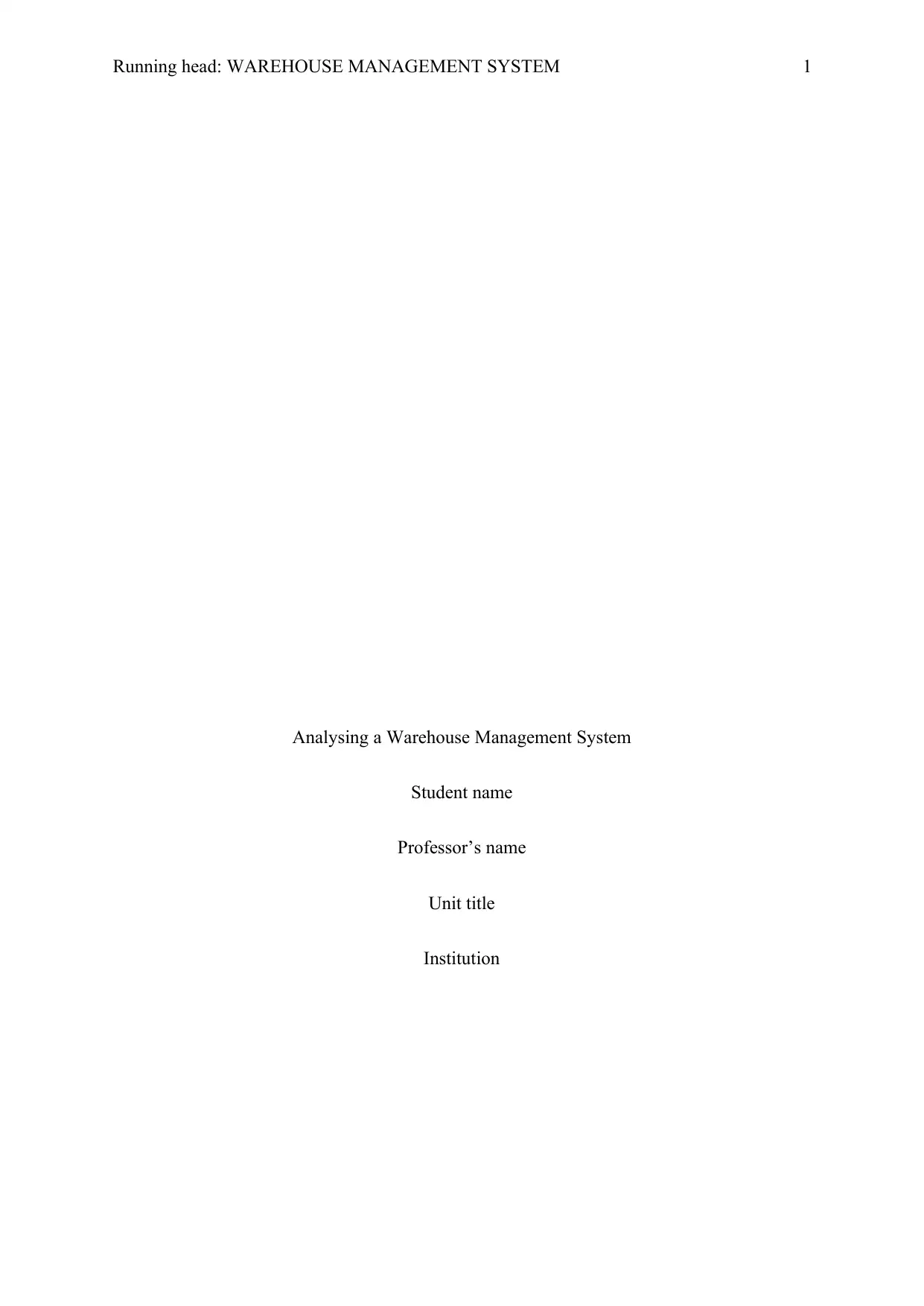
Running head: WAREHOUSE MANAGEMENT SYSTEM 1
Analysing a Warehouse Management System
Student name
Professor’s name
Unit title
Institution
Analysing a Warehouse Management System
Student name
Professor’s name
Unit title
Institution
Paraphrase This Document
Need a fresh take? Get an instant paraphrase of this document with our AI Paraphraser
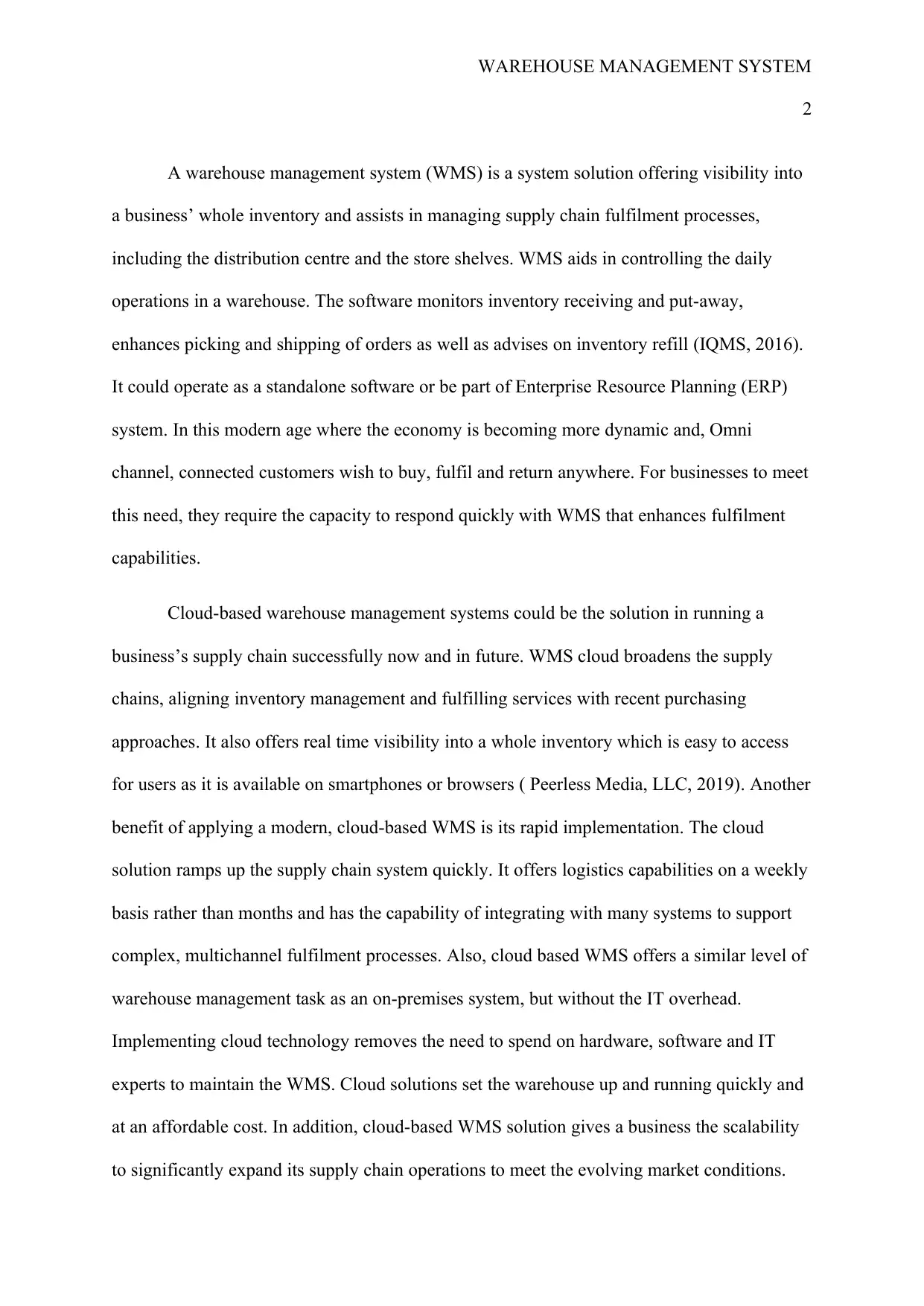
WAREHOUSE MANAGEMENT SYSTEM
2
A warehouse management system (WMS) is a system solution offering visibility into
a business’ whole inventory and assists in managing supply chain fulfilment processes,
including the distribution centre and the store shelves. WMS aids in controlling the daily
operations in a warehouse. The software monitors inventory receiving and put-away,
enhances picking and shipping of orders as well as advises on inventory refill (IQMS, 2016).
It could operate as a standalone software or be part of Enterprise Resource Planning (ERP)
system. In this modern age where the economy is becoming more dynamic and, Omni
channel, connected customers wish to buy, fulfil and return anywhere. For businesses to meet
this need, they require the capacity to respond quickly with WMS that enhances fulfilment
capabilities.
Cloud-based warehouse management systems could be the solution in running a
business’s supply chain successfully now and in future. WMS cloud broadens the supply
chains, aligning inventory management and fulfilling services with recent purchasing
approaches. It also offers real time visibility into a whole inventory which is easy to access
for users as it is available on smartphones or browsers ( Peerless Media, LLC, 2019). Another
benefit of applying a modern, cloud-based WMS is its rapid implementation. The cloud
solution ramps up the supply chain system quickly. It offers logistics capabilities on a weekly
basis rather than months and has the capability of integrating with many systems to support
complex, multichannel fulfilment processes. Also, cloud based WMS offers a similar level of
warehouse management task as an on-premises system, but without the IT overhead.
Implementing cloud technology removes the need to spend on hardware, software and IT
experts to maintain the WMS. Cloud solutions set the warehouse up and running quickly and
at an affordable cost. In addition, cloud-based WMS solution gives a business the scalability
to significantly expand its supply chain operations to meet the evolving market conditions.
2
A warehouse management system (WMS) is a system solution offering visibility into
a business’ whole inventory and assists in managing supply chain fulfilment processes,
including the distribution centre and the store shelves. WMS aids in controlling the daily
operations in a warehouse. The software monitors inventory receiving and put-away,
enhances picking and shipping of orders as well as advises on inventory refill (IQMS, 2016).
It could operate as a standalone software or be part of Enterprise Resource Planning (ERP)
system. In this modern age where the economy is becoming more dynamic and, Omni
channel, connected customers wish to buy, fulfil and return anywhere. For businesses to meet
this need, they require the capacity to respond quickly with WMS that enhances fulfilment
capabilities.
Cloud-based warehouse management systems could be the solution in running a
business’s supply chain successfully now and in future. WMS cloud broadens the supply
chains, aligning inventory management and fulfilling services with recent purchasing
approaches. It also offers real time visibility into a whole inventory which is easy to access
for users as it is available on smartphones or browsers ( Peerless Media, LLC, 2019). Another
benefit of applying a modern, cloud-based WMS is its rapid implementation. The cloud
solution ramps up the supply chain system quickly. It offers logistics capabilities on a weekly
basis rather than months and has the capability of integrating with many systems to support
complex, multichannel fulfilment processes. Also, cloud based WMS offers a similar level of
warehouse management task as an on-premises system, but without the IT overhead.
Implementing cloud technology removes the need to spend on hardware, software and IT
experts to maintain the WMS. Cloud solutions set the warehouse up and running quickly and
at an affordable cost. In addition, cloud-based WMS solution gives a business the scalability
to significantly expand its supply chain operations to meet the evolving market conditions.
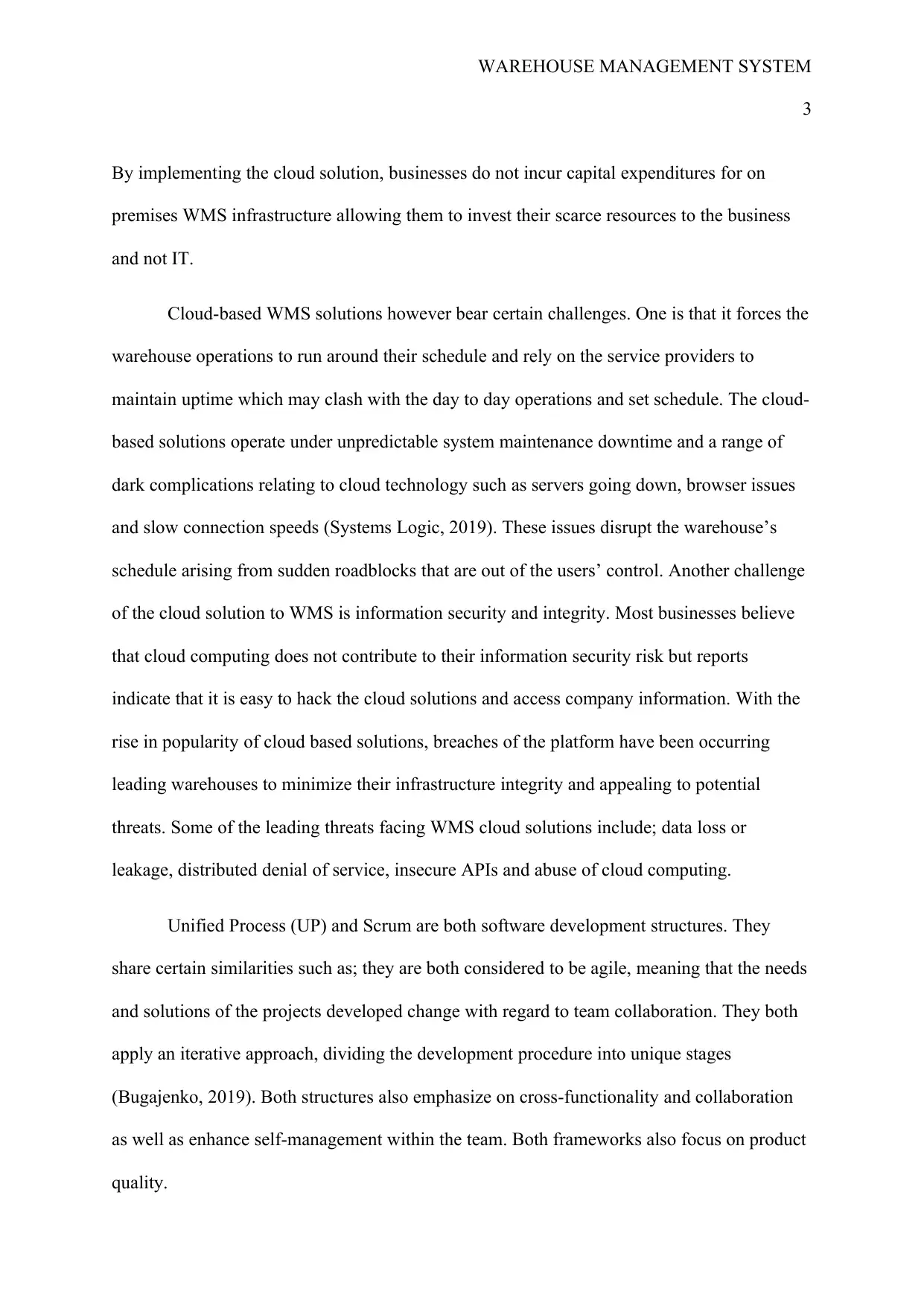
WAREHOUSE MANAGEMENT SYSTEM
3
By implementing the cloud solution, businesses do not incur capital expenditures for on
premises WMS infrastructure allowing them to invest their scarce resources to the business
and not IT.
Cloud-based WMS solutions however bear certain challenges. One is that it forces the
warehouse operations to run around their schedule and rely on the service providers to
maintain uptime which may clash with the day to day operations and set schedule. The cloud-
based solutions operate under unpredictable system maintenance downtime and a range of
dark complications relating to cloud technology such as servers going down, browser issues
and slow connection speeds (Systems Logic, 2019). These issues disrupt the warehouse’s
schedule arising from sudden roadblocks that are out of the users’ control. Another challenge
of the cloud solution to WMS is information security and integrity. Most businesses believe
that cloud computing does not contribute to their information security risk but reports
indicate that it is easy to hack the cloud solutions and access company information. With the
rise in popularity of cloud based solutions, breaches of the platform have been occurring
leading warehouses to minimize their infrastructure integrity and appealing to potential
threats. Some of the leading threats facing WMS cloud solutions include; data loss or
leakage, distributed denial of service, insecure APIs and abuse of cloud computing.
Unified Process (UP) and Scrum are both software development structures. They
share certain similarities such as; they are both considered to be agile, meaning that the needs
and solutions of the projects developed change with regard to team collaboration. They both
apply an iterative approach, dividing the development procedure into unique stages
(Bugajenko, 2019). Both structures also emphasize on cross-functionality and collaboration
as well as enhance self-management within the team. Both frameworks also focus on product
quality.
3
By implementing the cloud solution, businesses do not incur capital expenditures for on
premises WMS infrastructure allowing them to invest their scarce resources to the business
and not IT.
Cloud-based WMS solutions however bear certain challenges. One is that it forces the
warehouse operations to run around their schedule and rely on the service providers to
maintain uptime which may clash with the day to day operations and set schedule. The cloud-
based solutions operate under unpredictable system maintenance downtime and a range of
dark complications relating to cloud technology such as servers going down, browser issues
and slow connection speeds (Systems Logic, 2019). These issues disrupt the warehouse’s
schedule arising from sudden roadblocks that are out of the users’ control. Another challenge
of the cloud solution to WMS is information security and integrity. Most businesses believe
that cloud computing does not contribute to their information security risk but reports
indicate that it is easy to hack the cloud solutions and access company information. With the
rise in popularity of cloud based solutions, breaches of the platform have been occurring
leading warehouses to minimize their infrastructure integrity and appealing to potential
threats. Some of the leading threats facing WMS cloud solutions include; data loss or
leakage, distributed denial of service, insecure APIs and abuse of cloud computing.
Unified Process (UP) and Scrum are both software development structures. They
share certain similarities such as; they are both considered to be agile, meaning that the needs
and solutions of the projects developed change with regard to team collaboration. They both
apply an iterative approach, dividing the development procedure into unique stages
(Bugajenko, 2019). Both structures also emphasize on cross-functionality and collaboration
as well as enhance self-management within the team. Both frameworks also focus on product
quality.
⊘ This is a preview!⊘
Do you want full access?
Subscribe today to unlock all pages.

Trusted by 1+ million students worldwide
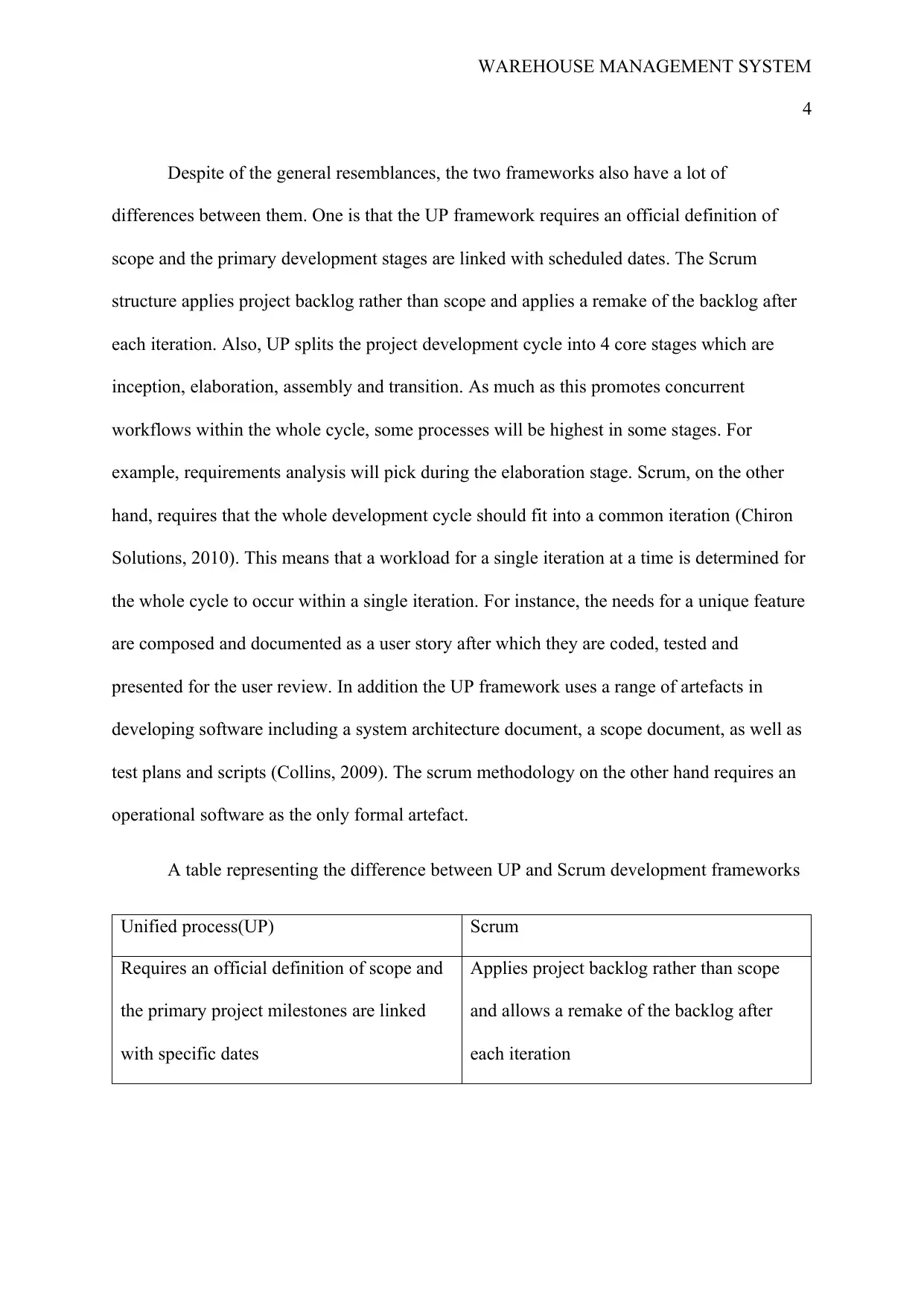
WAREHOUSE MANAGEMENT SYSTEM
4
Despite of the general resemblances, the two frameworks also have a lot of
differences between them. One is that the UP framework requires an official definition of
scope and the primary development stages are linked with scheduled dates. The Scrum
structure applies project backlog rather than scope and applies a remake of the backlog after
each iteration. Also, UP splits the project development cycle into 4 core stages which are
inception, elaboration, assembly and transition. As much as this promotes concurrent
workflows within the whole cycle, some processes will be highest in some stages. For
example, requirements analysis will pick during the elaboration stage. Scrum, on the other
hand, requires that the whole development cycle should fit into a common iteration (Chiron
Solutions, 2010). This means that a workload for a single iteration at a time is determined for
the whole cycle to occur within a single iteration. For instance, the needs for a unique feature
are composed and documented as a user story after which they are coded, tested and
presented for the user review. In addition the UP framework uses a range of artefacts in
developing software including a system architecture document, a scope document, as well as
test plans and scripts (Collins, 2009). The scrum methodology on the other hand requires an
operational software as the only formal artefact.
A table representing the difference between UP and Scrum development frameworks
Unified process(UP) Scrum
Requires an official definition of scope and
the primary project milestones are linked
with specific dates
Applies project backlog rather than scope
and allows a remake of the backlog after
each iteration
4
Despite of the general resemblances, the two frameworks also have a lot of
differences between them. One is that the UP framework requires an official definition of
scope and the primary development stages are linked with scheduled dates. The Scrum
structure applies project backlog rather than scope and applies a remake of the backlog after
each iteration. Also, UP splits the project development cycle into 4 core stages which are
inception, elaboration, assembly and transition. As much as this promotes concurrent
workflows within the whole cycle, some processes will be highest in some stages. For
example, requirements analysis will pick during the elaboration stage. Scrum, on the other
hand, requires that the whole development cycle should fit into a common iteration (Chiron
Solutions, 2010). This means that a workload for a single iteration at a time is determined for
the whole cycle to occur within a single iteration. For instance, the needs for a unique feature
are composed and documented as a user story after which they are coded, tested and
presented for the user review. In addition the UP framework uses a range of artefacts in
developing software including a system architecture document, a scope document, as well as
test plans and scripts (Collins, 2009). The scrum methodology on the other hand requires an
operational software as the only formal artefact.
A table representing the difference between UP and Scrum development frameworks
Unified process(UP) Scrum
Requires an official definition of scope and
the primary project milestones are linked
with specific dates
Applies project backlog rather than scope
and allows a remake of the backlog after
each iteration
Paraphrase This Document
Need a fresh take? Get an instant paraphrase of this document with our AI Paraphraser
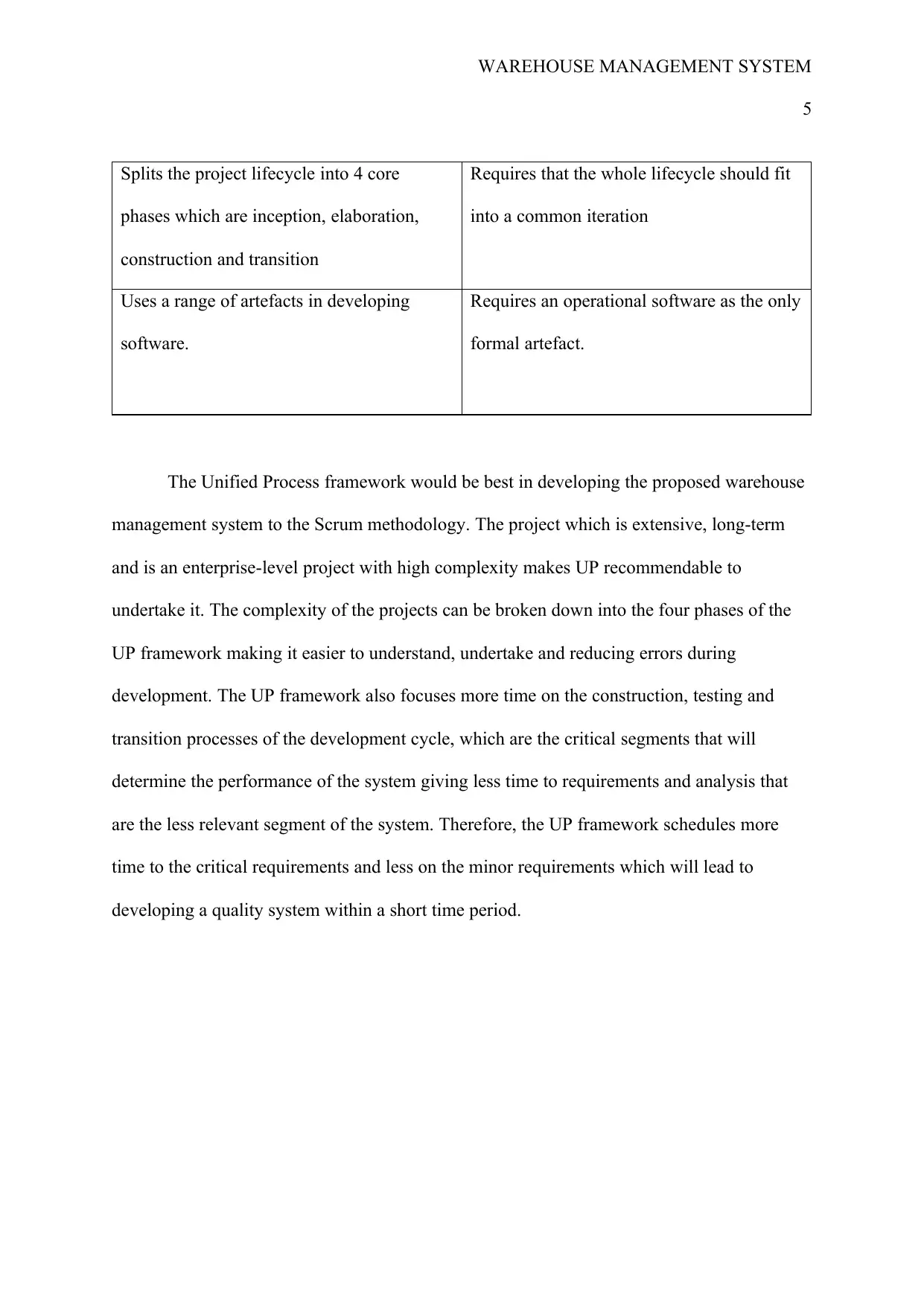
WAREHOUSE MANAGEMENT SYSTEM
5
Splits the project lifecycle into 4 core
phases which are inception, elaboration,
construction and transition
Requires that the whole lifecycle should fit
into a common iteration
Uses a range of artefacts in developing
software.
Requires an operational software as the only
formal artefact.
The Unified Process framework would be best in developing the proposed warehouse
management system to the Scrum methodology. The project which is extensive, long-term
and is an enterprise-level project with high complexity makes UP recommendable to
undertake it. The complexity of the projects can be broken down into the four phases of the
UP framework making it easier to understand, undertake and reducing errors during
development. The UP framework also focuses more time on the construction, testing and
transition processes of the development cycle, which are the critical segments that will
determine the performance of the system giving less time to requirements and analysis that
are the less relevant segment of the system. Therefore, the UP framework schedules more
time to the critical requirements and less on the minor requirements which will lead to
developing a quality system within a short time period.
5
Splits the project lifecycle into 4 core
phases which are inception, elaboration,
construction and transition
Requires that the whole lifecycle should fit
into a common iteration
Uses a range of artefacts in developing
software.
Requires an operational software as the only
formal artefact.
The Unified Process framework would be best in developing the proposed warehouse
management system to the Scrum methodology. The project which is extensive, long-term
and is an enterprise-level project with high complexity makes UP recommendable to
undertake it. The complexity of the projects can be broken down into the four phases of the
UP framework making it easier to understand, undertake and reducing errors during
development. The UP framework also focuses more time on the construction, testing and
transition processes of the development cycle, which are the critical segments that will
determine the performance of the system giving less time to requirements and analysis that
are the less relevant segment of the system. Therefore, the UP framework schedules more
time to the critical requirements and less on the minor requirements which will lead to
developing a quality system within a short time period.
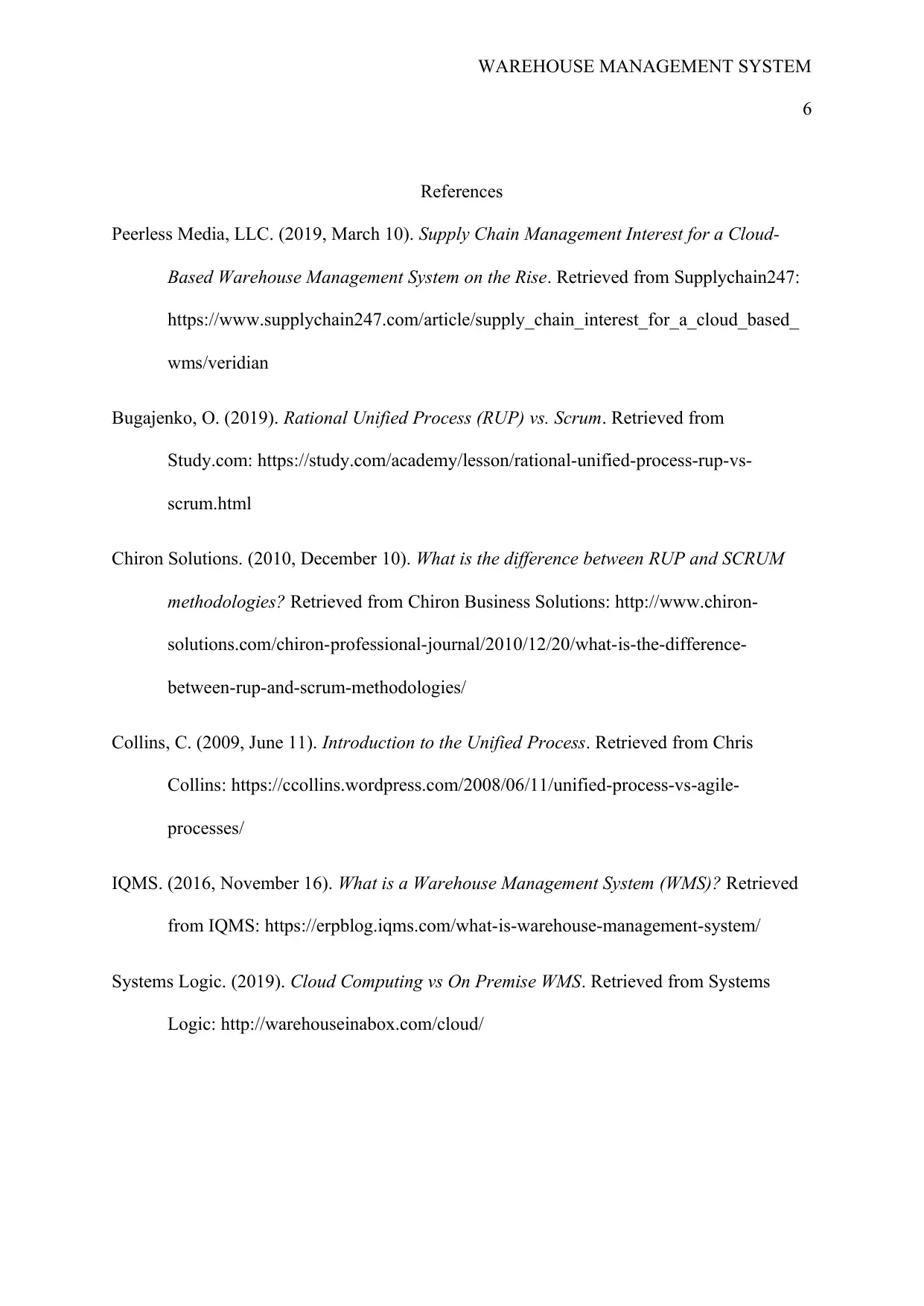
WAREHOUSE MANAGEMENT SYSTEM
6
References
Peerless Media, LLC. (2019, March 10). Supply Chain Management Interest for a Cloud-
Based Warehouse Management System on the Rise. Retrieved from Supplychain247:
https://www.supplychain247.com/article/supply_chain_interest_for_a_cloud_based_
wms/veridian
Bugajenko, O. (2019). Rational Unified Process (RUP) vs. Scrum. Retrieved from
Study.com: https://study.com/academy/lesson/rational-unified-process-rup-vs-
scrum.html
Chiron Solutions. (2010, December 10). What is the difference between RUP and SCRUM
methodologies? Retrieved from Chiron Business Solutions: http://www.chiron-
solutions.com/chiron-professional-journal/2010/12/20/what-is-the-difference-
between-rup-and-scrum-methodologies/
Collins, C. (2009, June 11). Introduction to the Unified Process. Retrieved from Chris
Collins: https://ccollins.wordpress.com/2008/06/11/unified-process-vs-agile-
processes/
IQMS. (2016, November 16). What is a Warehouse Management System (WMS)? Retrieved
from IQMS: https://erpblog.iqms.com/what-is-warehouse-management-system/
Systems Logic. (2019). Cloud Computing vs On Premise WMS. Retrieved from Systems
Logic: http://warehouseinabox.com/cloud/
6
References
Peerless Media, LLC. (2019, March 10). Supply Chain Management Interest for a Cloud-
Based Warehouse Management System on the Rise. Retrieved from Supplychain247:
https://www.supplychain247.com/article/supply_chain_interest_for_a_cloud_based_
wms/veridian
Bugajenko, O. (2019). Rational Unified Process (RUP) vs. Scrum. Retrieved from
Study.com: https://study.com/academy/lesson/rational-unified-process-rup-vs-
scrum.html
Chiron Solutions. (2010, December 10). What is the difference between RUP and SCRUM
methodologies? Retrieved from Chiron Business Solutions: http://www.chiron-
solutions.com/chiron-professional-journal/2010/12/20/what-is-the-difference-
between-rup-and-scrum-methodologies/
Collins, C. (2009, June 11). Introduction to the Unified Process. Retrieved from Chris
Collins: https://ccollins.wordpress.com/2008/06/11/unified-process-vs-agile-
processes/
IQMS. (2016, November 16). What is a Warehouse Management System (WMS)? Retrieved
from IQMS: https://erpblog.iqms.com/what-is-warehouse-management-system/
Systems Logic. (2019). Cloud Computing vs On Premise WMS. Retrieved from Systems
Logic: http://warehouseinabox.com/cloud/
⊘ This is a preview!⊘
Do you want full access?
Subscribe today to unlock all pages.

Trusted by 1+ million students worldwide
1 out of 6
Related Documents
Your All-in-One AI-Powered Toolkit for Academic Success.
+13062052269
info@desklib.com
Available 24*7 on WhatsApp / Email
![[object Object]](/_next/static/media/star-bottom.7253800d.svg)
Unlock your academic potential
Copyright © 2020–2025 A2Z Services. All Rights Reserved. Developed and managed by ZUCOL.



